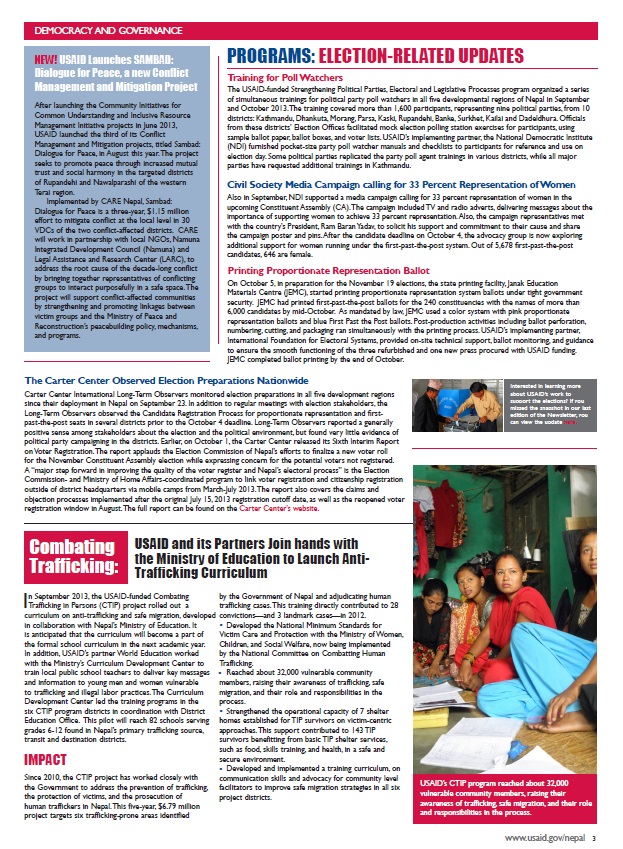Home » Democracy and Governance Programs: Election-Related Updates
Training for Poll Watchers
The USAID-funded Strengthening Political Parties, Electoral and Legislative Processes program organized a series of simultaneous trainings for political party poll watchers in all five developmental regions of Nepal in September and October 2013. The training covered more than 1,600 participants, representing nine political parties, from 10 districts: Kathmandu, Dhankuta, Morang, Parsa, Kaski, Rupandehi, Banke, Surkhet, Kailai and Dadeldhura. Officials from these districts’ Election Offices facilitated mock election polling station exercises for participants, using sample ballot paper, ballot boxes, and voter lists. USAID’s implementing partner, the National Democratic Institute (NDI) furnished pocket-size party poll watcher manuals and checklists to participants for reference and use on election day. Some political parties replicated the party poll agent trainings in various districts, while all major parties have requested additional trainings in Kathmandu.
Civil Society Media Campaign calling for 33 Percent Representation of Women
Also in September, NDI supported a media campaign calling for 33 percent representation of women in the upcoming Constituent Assembly (CA). The campaign included TV and radio adverts, delivering messages about the importance of supporting women to achieve 33 percent representation. Also, the campaign representatives met with the country’s President, Ram Baran Yadav, to solicit his support and commitment to their cause and share the campaign poster and pins. After the candidate deadline on October 4, the advocacy group is now exploring additional support for women running under the first-past-the-post system. Out of 5,678 first-past-the-post candidates, 646 are female.
Printing Proportionate Representation Ballot
On October 5, in preparation for the November 19 elections, the state printing facility, Janak Education Materials Centre (JEMC), started printing proportionate representation system ballots under tight government security. JEMC had printed first-past-the-post ballots for the 240 constituencies with the names of more than 6,000 candidates by mid-October. As mandated by law, JEMC used a color system with pink proportionate representation ballots and blue First Past the Post ballots. Post-production activities including ballot perforation, numbering, cutting, and packaging ran simultaneously with the printing process. USAID’s implementing partner, International Foundation for Electoral Systems, provided on-site technical support, ballot monitoring, and guidance to ensure the smooth functioning of the three refurbished and one new press procured with USAID funding. JEMC completed ballot printing by the end of October.
The Carter Center Observed Election Preparations Nationwide
Carter Center International Long-Term Observers monitored election preparations in all five development regions since their deployment in Nepal on September 23. In addition to regular meetings with election stakeholders, the Long-Term Observers observed the Candidate Registration Process for proportionate representation and first-past-the-post seats in several districts prior to the October 4 deadline. Long-Term Observers reported a generally positive sense among stakeholders about the election and the political environment, but found very little evidence of political party campaigning in the districts. Earlier, on October 1, the Carter Center released its Sixth Interim Report on Voter Registration. The report applauds the Election Commission of Nepal’s efforts to finalize a new voter roll for the November Constituent Assembly election while expressing concern for the potential voters not registered. A “major step forward in improving the quality of the voter register and Nepal’s electoral process” is the Election Commission- and Ministry of Home Affairs-coordinated program to link voter registration and citizenship registration outside of district headquarters via mobile camps from March-July 2013. The report also covers the claims and objection processes implemented after the original July 15, 2013 registration cutoff date, as well as the reopened voter registration window in August. The full report can be found on the Carter Center’s website.
For more Democracy and Governance updates, click the picture.
Date
Friday, November 22, 2013 - 3:45am








Comment
Make a general inquiry or suggest an improvement.